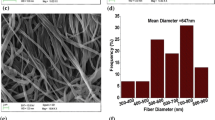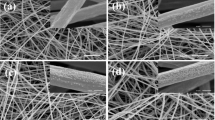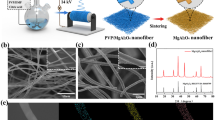Abstract
Synergistic coupling of polymer with highly Na+ conducting ceramics is an effective approach to alleviate the poor thermal stability and low ionic conductivity challenges of an electrolyte. Herein, we have reported a rational design of Na2Zn1.97Ca0.03TeO6 (NZCTO) nanofillers–reinforced poly(vinylidene fluoride)-co-hexafluoropropylene (PVDF-HFP)-based 3D-electrospun nanofibrous hybrid polymer membrane (ESHPM) as a separator cum electrolyte obtained by an electrospinning technique. Physico-chemical properties of NZCTO and ESHPMs were characterized for its morphology, porosity and electrolyte uptake measurement, crystallinity, thermal stability, dimensional stability, operating potential window, and ionic conductivity. ESHPME immobilizing a liquid electrolyte solution [1 M of sodium hexafluorophosphate (NaPF6)] in ethylene carbonate (EC)/dimethyl carbonate (DMC), 1/1v/v) exhibited an excellent ionic conductivity (σRT ⁓ 1.47 × 10−3 S cm−1). A Na-ion capacitor (NIC) comprising high-capacity NaCo0.7Al0.3O2 (NCAO) and rapid ion–absorbing activated carbon (AC)-based electrodes with ESHPM (10 wt.% NZCTO) electrolyte delivers the specific capacitance of 103.57 Fg−1 at the current density of 1 Ag−1. This NIC retains 89% of its initial capacitance up to 1000 charge–discharge cycles. Furthermore, NIC demonstrated a maximum energy and power density of ⁓ 36.82 W h kg−1 and ⁓ 5.71 kW kg−1, respectively. This research promises to develop high-performing NICs with high energy and power densities.
Graphical Abstract
Schematic illustration of Na-ion capacitor (NIC) device employing Na+ conducting filler embedded 3D-electrospun nanofibrous hybrid solid polymer membrane electrolyte.






Similar content being viewed by others
References
Simon P, Gogotsi Y (2008) Materials for electrochemical capacitors. Nat Mater 7(11):845–854. https://doi.org/10.1038/nmat2297
Conway BE (1999) Similarities and differences between supercapacitors and batteries for storing electrical energy. In: Electrochemical supercapacitors: scientific fundamentals and technological applications. Springer US, Boston, MA, pp 11–31. https://doi.org/10.1007/978-1-4757-3058-6_2
Zhong C, Deng Y, Hu W, Qiao J, Zhang L, Zhang J (2015) A review of electrolyte materials and compositions for electrochemical supercapacitors. Chem Soc Rev 44(21):7484–7539. https://doi.org/10.1039/C5CS00303B
Ellis BL, Nazar LF (2012) Sodium and sodium-ion energy storage batteries. Curr Opin Solid State Mater Sci 16(4):168–177. https://doi.org/10.1016/j.cossms.2012.04.002
Zhao X, Zhang Y, Wang Y, Wei H (2019) Battery-type electrode materials for sodium-ion capacitors 2(11):899–917. https://doi.org/10.1002/batt.201900082
Zuo W, Li R, Zhou C, Li Y, Xia J, Liu J (2017) Battery-supercapacitor hybrid devices: recent progress and future prospects 4(7):1600539. https://doi.org/10.1002/advs.201600539
Arunachalam S, Kirubasankar B, Pan D, Liu H, Yan C, Guo Z, Angaiah S (2020) Research progress in rare earths and their composites based electrode materials for supercapacitors. Green Energy Environ 5(3):259–273. https://doi.org/10.1016/j.gee.2020.07.021
Hou C, Wang B, Murugadoss V, Vupputuri S, Chao Y, Guo Z, Wang C, Du W (2020) Recent advances in Co3O4 as anode materials for high-performance lithium-ion batteries. Eng Sci 11:19–30. https://doi.org/10.30919/es8d1128
Peng Z, Jiang Q, Peng P, Li F-F (2021) NH3-activated fullerene derivative hierarchical microstructures to porous Fe3O4/N-C for oxygen reduction reaction and Zn-air battery. Eng Sci 14:27–38. https://doi.org/10.30919/es8d1311
Wang H, Zhu C, Chao D, Yan Q, Fan HJ (2017) Nonaqueous hybrid lithium-ion and sodium-ion capacitors 29(46):1702093. https://doi.org/10.1002/adma.201702093
Poonam SK, Arora A, Tripathi SK (2019) Review of supercapacitors: materials and devices. J Energy Storage 21:801–825. https://doi.org/10.1016/j.est.2019.01.010
Yuan Y, Wang C, Lei K, Li H, Li F, Chen J (2018) Sodium-ion hybrid capacitor of high power and energy density. ACS Cent Sci 4(9):1261–1265. https://doi.org/10.1021/acscentsci.8b00437
Feng W, Zhang J, Yusuf A, Ao X, Shi D, Etacheri V, Wang D-Y (2022) Quasi-solid-state sodium-ion hybrid capacitors enabled by UiO-66@PVDF-HFP multifunctional separators: Selective charge transfer and high fire safety. Chem Eng J 427:130919. https://doi.org/10.1016/j.cej.2021.130919
Meng F, Long T, Xu B, Zhao Y, Hu Z, Zhang L, Liu J (2020) Electrolyte technologies for high performance sodium-ion capacitors. 8(652). https://doi.org/10.3389/fchem.2020.00652
Rajeevan S, John S, George SC (2021) Polyvinylidene fluoride: a multifunctional polymer in supercapacitor applications. J Power Sources 504:230037. https://doi.org/10.1016/j.jpowsour.2021.230037
Yu X, Manthiram A (2021) A review of composite polymer-ceramic electrolytes for lithium batteries. Energy Storage Mater 34:282–300. https://doi.org/10.1016/j.ensm.2020.10.006
Zhang Z, Zhang Q, Ren C, Luo F, Ma Q, Hu Y-S, Zhou Z, Li H, Huang X, Chen L (2016) A ceramic/polymer composite solid electrolyte for sodium batteries. J Mater Chem A 4(41):15823–15828. https://doi.org/10.1039/C6TA07590H
Boaretto N, Meabe L, Martinez-Ibañez M, Armand M, Zhang H (2020) Review—polymer electrolytes for rechargeable batteries: from nanocomposite to nanohybrid. J Electrochem Soc 167(7):070524. https://doi.org/10.1149/1945-7111/ab7221
Keller M, Varzi A, Passerini S (2018) Hybrid electrolytes for lithium metal batteries. J Power Sources 392:206–225. https://doi.org/10.1016/j.jpowsour.2018.04.099
Evstigneeva MA, Nalbandyan VB, Petrenko AA, Medvedev BS, Kataev AA (2011) A new family of fast sodium ion conductors: Na2M2TeO6 (M = Ni Co, Zn, Mg). Chem Mater 23(5):1174–1181. https://doi.org/10.1021/cm102629g
Wu J-F, Wang Q, Guo X (2018) Sodium-ion conduction in Na2Zn2TeO6 solid electrolytes. J Power Sources 402:513–518. https://doi.org/10.1016/j.jpowsour.2018.09.048
Deng Z, Gu J, Li Y, Li S, Peng J, Li X, Luo J, Huang Y, Fang C, Li Q, Han J, Huang Y, Zhao Y (2019) Ca-doped Na2Zn2TeO6 layered sodium conductor for all-solid-state sodium-ion batteries. Electrochim Acta 298:121–126. https://doi.org/10.1016/j.electacta.2018.12.092
Wei K, Kim I-S (2014) Application of nanofibers in supercapacitors. In. pp 163–181. https://doi.org/10.1007/978-3-642-54160-5_7
Liang J, Zhao H, Yue L, Fan G, Li T, Lu S, Chen G, Gao S, Asiri Abdullah M, Sun X (2020) Recent advances in electrospun nanofibers for supercapacitors. J Mater Chem A 8(33):16747–16789. https://doi.org/10.1039/D0TA05100D
Maurya DK, Murugadoss V, Guo Z, Angaiah S (2021) Designing Na2Zn2TeO6-embedded 3D-nanofibrous poly(vinylidenefluoride)-co-hexafluoropropylene-based nanohybrid electrolyte via electrospinning for durable sodium-ion capacitors. ACS Appl Energy Mater. https://doi.org/10.1021/acsaem.1c01682
Solarajan AK, Murugadoss V, Angaiah S (2016) Montmorillonite embedded electrospun PVdF–HFP nanocomposite membrane electrolyte for Li-ion capacitors. Appl Mater Today 5:33–40. https://doi.org/10.1016/j.apmt.2016.09.002
Maurya DK, Murugadoss V, Angaiah S (2019) All-solid-state electrospun poly(vinylidene fluoride-co-hexafluoropropylene)/Li7.1La3Ba0.05Zr1.95O12 nanohybrid membrane electrolyte for high-energy li-ion capacitors. J Phys Chem C 123 (50):30145–30154. https://doi.org/10.1021/acs.jpcc.9b09264
Maurya DK, Balan B, Murugadoss V, Yan C, Angaiah S (2020) A fast Li-ion conducting Li7.1La3Sr0.05Zr1.95O12 embedded electrospun PVDF-HFP nanohybrid membrane electrolyte for all-solid-state Li-ion capacitors. Mater Today Commun 25:101497. https://doi.org/10.1016/j.mtcomm.2020.101497
Singh K, Kirubasankar B, Angaiah S (2017) Synthesis and electrochemical performance of P2-Na0.67AlxCo1-xO2 (0.0 ≤ × ≤ 0.5) nanopowders for sodium-ion capacitors. Ionics 23 (3):731–739. https://doi.org/10.1007/s11581-016-1821-z
Li Y, Deng Z, Peng J, Gu J, Chen E, Yu Y, Wu J, Li X, Luo J, Huang Y, Xu Y, Gao Z, Fang C, Zhu J, Li Q, Han J, Huang Y (2018) New P2-type honeycomb-layered sodium-ion conductor: Na2Mg2TeO6. ACS Appl Mater Interfaces 10(18):15760–15766. https://doi.org/10.1021/acsami.8b03938
Li Y, Deng Z, Peng J, Chen E, Yu Y, Li X, Luo J, Huang Y, Zhu J, Fang C, Li Q, Han J, Huang Y (2018) A P2-type layered superionic conductor Ga-Doped Na2Zn2TeO6 for all-solid-state sodium-ion batteries. Chem Eur J 24(5):1057–1061. https://doi.org/10.1002/chem.201705466
Dubey M, Kumar A, Murugavel S, Prakash GV, Jose DA, Mariappan CR (2020) Structural and ion transport properties of sodium ion conducting Na2MTeO6 (M= MgNi and MgZn) solid electrolytes. Ceram Int 46(1):663–671. https://doi.org/10.1016/j.ceramint.2019.09.018
Solarajan AK, Murugadoss V, Angaiah S (2017) Dimensional stability and electrochemical behaviour of ZrO2 incorporated electrospun PVdF-HFP based nanocomposite polymer membrane electrolyte for Li-ion capacitors. Sci Rep 7(1):45390. https://doi.org/10.1038/srep45390
Wu Y, Li Y, Wang Y, Liu Q, Chen Q, Chen M (2022) Advances and prospects of PVDF based polymer electrolytes. J Energy Chem 64:62–84. https://doi.org/10.1016/j.jechem.2021.04.007
Sun Y, Jin F, Li J, Liu B, Chen X, Dong H, Mao Y, Gu W, Xu J, Shen Y, Wu X, Chen L (2020) Composite solid electrolyte for solid-state lithium batteries workable at room temperature. ACS Appl Energy Mater 3(12):12127–12133. https://doi.org/10.1021/acsaem.0c02226
Dinachandra Singh M, Dalvi A (2021) Ionic transport in NASICON-polymer hybrids: An assessment using X-ray photoelectron spectroscopy. Appl Surf Sci 536:147792. https://doi.org/10.1016/j.apsusc.2020.147792
Li M, Wang C, Chen Z, Xu K, Lu J (2020) New concepts in electrolytes. Chem Rev 120(14):6783–6819. https://doi.org/10.1021/acs.chemrev.9b00531
Shen X-l, Li Z-j, Deng N-p, Fan J, Wang L, Xia Z-p, Kang W-m, Liu Y (2020) A leaf-vein-like MnO2@PVDF nanofiber gel polymer electrolyte matrix for Li-ion capacitor with excellent thermal stability and improved cyclability. Chem Eng J 387:124058. https://doi.org/10.1016/j.cej.2020.124058
Shen X, Li Z, Deng N, Kang W, Fan J, Liu Y (2019) PVDF/TBAPF6 hierarchical nanofiber gel membrane for lithium ion capacitor with ultrahigh ion conductivity and excellent interfacial compatibility. Electrochim Acta 318:801–808. https://doi.org/10.1016/j.electacta.2019.06.095
Zhang Y, Jiang J, An Y, Wu L, Dou H, Zhang J, Zhang Y, Wu S, Dong M, Zhang X, Guo Z (2020) Sodium-ion capacitors: materials, mechanism, and challenges. Chemsuschem 13(10):2522–2539. https://doi.org/10.1002/cssc.201903440
Acknowledgements
Authors are grateful to Central Instrumentation Facility, Pondicherry University, for providing the characterization facility.
Funding
Prof. A.S acknowledges the University Grants Commission (UGC), New Delhi, for their financial support under BSR Mid-Career Award Scheme (No. F.19–214/2018).
Author information
Authors and Affiliations
Corresponding author
Ethics declarations
Conflict of interest
The authors declare no competing interest.
Additional information
Publisher's Note
Springer Nature remains neutral with regard to jurisdictional claims in published maps and institutional affiliations.
Supplementary Information
Below is the link to the electronic supplementary material.
Rights and permissions
Springer Nature or its licensor (e.g. a society or other partner) holds exclusive rights to this article under a publishing agreement with the author(s) or other rightsholder(s); author self-archiving of the accepted manuscript version of this article is solely governed by the terms of such publishing agreement and applicable law.
About this article
Cite this article
Maurya, D.K., Dhanusuraman, R., Guo, J.Z. et al. Na-ion conducting filler embedded 3D-electrospun nanofibrous hybrid solid polymer membrane electrolyte for high-performance Na-ion capacitor. Adv Compos Hybrid Mater 6, 45 (2023). https://doi.org/10.1007/s42114-022-00604-1
Received:
Revised:
Accepted:
Published:
DOI: https://doi.org/10.1007/s42114-022-00604-1




